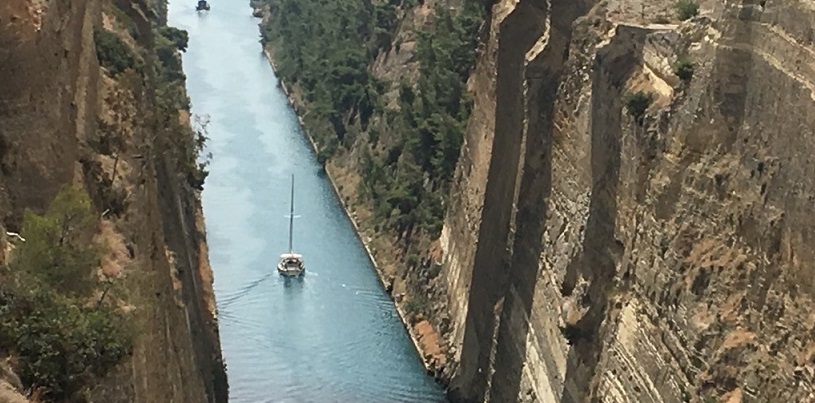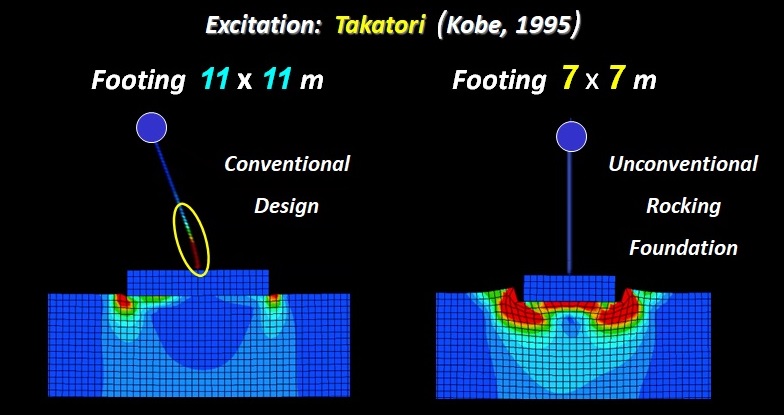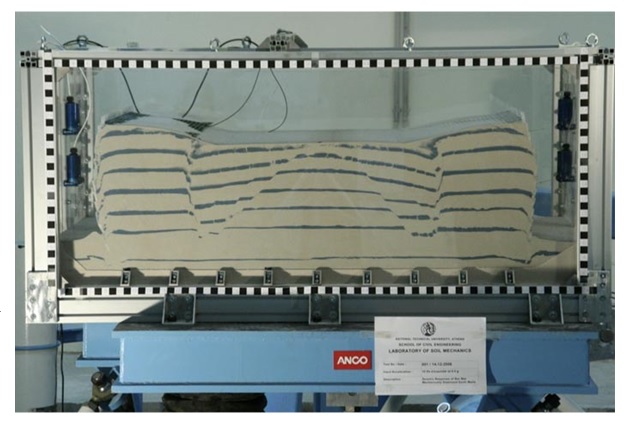Completed Research Projects
‘’Critical state soil mechanics revisited: fabric effects’’ (Funding: European Research Council, FP7-ERC-IDEAS Advanced Grant Agreement n0 290963 with acronym SOMEF). 2014-2018. The experimental part of the project was executed in the Soil Mechanics Laboratory. The HC apparatus was used for the investigation of the effects of anisotropy on the critical state behaviour of sand and has provided the experimental evidence that the Critical State Theory requires revision to account for fabric anisotropy.
“NANO-LIQ: Mitigation of seismic liquefaction in the foundation soil of existing structures via pore fluid enrichment with environmentally safe nano-particles”, Project code: MIS 375618. (funding: European Social Fund and Greek national funds). 2013 –2015. As part of the project the experimental investigation of the behaviour of sands stabilised with colloidal nano-silica hydrosol was carried out in the Soil Mechanics Laboratory. It was shown that pore water pressure measurement is paramount to understand fundamental behaviour of treated sands; albeit being ignored in previous studies. To eliminate shortcomings of pore pressure development under undrained monotonic and cyclic loading stringent experimental techniques had to be applied to examine cause-effect relationships. The treated sands were regarded as structured soils exhibiting enhanced shearing resistance at peak strength but mobilising the same stress ratio with the sand at ultimate strength. Differences become insignificant at high stress levels.
‘’Mechanical response of stiff clays’’, (funding: NTUA’s Basic Research Framework Program PEVE 2009-2011). The mechanical response of stiff clays was examined in the context of critical state soil mechanics theory. Medium and high pressure triaxial cells and high pressure oedometer were used for testing a number of intact and reconstituted natural soils including the Corinth Marl which is a clayey silt. The response of the reconstituted materials can be used as a reference to assess the influence of the microstructure on the compressibility and strength of the intact materials within the framework proposed for clays by prof. Burland in his Rankine lecture. The results are found to give clear signs of structure in both compression and shearing.
‘’Anisotropic response of non-cohesive soils under tortional shearing’’, (Funding: EU, Greek Ministry of Education_ HERACLETUS II). 2010-2013. The anisotropy of two standard research sands was examined in the HC apparatus. Apart from the fundamental understanding of sand behaviour this work highlighted two novel findings: under free rotation of principal stresses with increasing shear stress, constant stress ratios mobilised at instability, phase transformation and failure are associated with a constant rotation respectively; implying that the load carrying structure re-adjusts to a specific combination of applied stress ratio and rotation. Second under simple shear the angle of shearing resistance mobilised at phase transformation reduces significantly with density.
‘’The behaviour of granular soils under static and dynamic loading in the Hollow Cylinder apparatus’’, (funding: NTUA’s Basic Research Framework Program LEYKIPPOS, PEVE). 2006-2008. Simple shear tests were performed on four fine to sands. Two characteristic sand behaviours were observed: a stable response with continuously increasing shear stress and an unstable response (brittle) with temporarily decreasing shear stress. Whether a sand exhibits stable or unstable response is determined by the shape of its grains rather than its grading. Cyclic response was related to monotonic response albeit all sands becoming unstable under cyclic loading. For sands showing stable response under monotonic loading the onset of cyclic instability is triggered at the phase transformation line instead of the instability line which triggers cyclic instability in brittle sands.
‘’Foundation design in seismically ‘problematic’ soils under strong ground shaking (X-SOILS)”, (funding: General Secretariat for Research and Technology (GSRT)). 2003-2006. Eight research groups equally divided between universities and consulting firms were all actively working to improve the state of understanding the fundamental behaviour of liquefiable soils and its implications on the design of foundations in seismic ‘problematic’ (X-SOILS) soils in Greece. The research spanned four main disciplines: site amplification of the seismic ground motion, the experimental (in-situ and laboratory) investigation and numerical simulation of the response of liquefiable soils, the seismic design of foundations under large displacements and improvement methods to mitigate the risk of liquefaction and/or lateral spreading of such ‘problematic’ soils. The Soil Mechanics Laboratory participated in all research disciplines with the Geotechnical and the Numerical and Dynamics Laboratory.
‘’Fault-Rupture and Strong Shaking Effects on the Safety of Composite Foundations and Pipeline Systems: Quantification and Reduction of Seismic Risk through the Application of Advanced Geotechnical Engineering Techniques (QUAKER)’’, (funding: European Comission). 2003-2006. Well documented case studies, geotechnical centrifuge model testing and advanced numerical modelling were used to analyse the behaviour of infrastructures very close to surface fault-rupture and the seismic performance of raked piles. The latter was calibrated against high quality experimental data on Fontainebleau sand. Experimental and field data and advanced numerical modelling were produced in the Geotechnical and the Numerical and Dynamics Laboratory respectively.
‘’Laboratory investigation of stiffness, G-γ curves, of representative Greek Soils”, (funding: Earthquake Planning and Protection Organization (OASP). A number of typical Greek soils was tested in the laboratory for the determination of stiffness variation with strain to be used in seismic hazard analyses. Local instrumentation was mounted on soil specimens to measure axial strains in the range of 0.001% to 1%. Results of bender element tests extended the range of low strains to less than 0.0005%.
‘’Soil-Foundation-Structure Systems Beyond Conventional Seismic ‘Failure’ Thresholds: Application to New or Existing Structures and Monuments (DARE)’’, (funding European Commission, FP7 (Ideas)). 2009-2915. The idea of allowing “below-ground” support systems to exceed conventional ‘thresholds’ defining failure in current design codes, in response to strong seismic shaking, has been explored. Numerical simulations as well as small-scale pushover and shaking table tests were performed at the NTUA Soil Mechanics Laboratory to verify the above notion.
‘’Performance-Based Approach to Earthquake Protection of Cultural Heritage in European and Mediterranean Countries (PERPETUATE)’’, (funding: European Commission (FP7-Capacities)). 2009-2014. The seismic vulnerability of listed buildings and monuments was examined with the aid of advanced numerical modelling, experiments in the shaking table (dynamic loading) and the laminar box (ground induced deformations under quasi-static loading). The soil-foundation-structure-system approach, described in previous project, was employed in the calculations further to conventional approaches.
‘’Resolution of Complex Problems in the Analysis of Next Generation Wind Turbine Towers (AIOLOS)’’, (funding: EU, Greek Ministry of Education_ THALIS). 2011-2015.
‘’Contemporary Evaluation Methodology of Seismic Vulnerability and Upgrade of Port Facilities (UPGRADE)’’, (funding: EU, Greek Ministry of Education_ THALIS). 2011-2015.
‘’Macroelement modelling of the non-linear response of pile groups’’, (funding: NTUA’s Basic Research Framework Program, PEVE). 2008-2011.
‘’Numerical and experimental investigation of the triggering, evolution and deposition of rapid landslides (PYTHAGORAS)’’, (funding: European Commission). 2004-2007. Mathematical models, constitutive relations and advanced numerical algorithms were developed to study the effects of topographic amplification of the seismic excitation, soil strain-softening, grain crushing, thermo-poro-plastic mechanics of soils, interbedded liquefiable soil layers on triggering rapid landslides. Additionally, the interaction of the sliding mass with overlying or stabilizing structures such as passive piles, caissons, diaphragm walls etc was simulated.
‘’Seismic Protection of Bridges (ASPROGE)’’, (funding: General Secretariat for Research and Technology (GSRT). 2003-2006. Existing numerical methods of analysis were evaluated and improved methods were implemented to address inelastic static analysis of the seismic response of bridges, issues of soil-pile-foundation-pier interaction, special variability of ground motion. Case studies from Kobe and Northridge earthquakes were thoroughly analyzed.
‘’Risk Mitigation for Earthquakes and Landslides (LESSLOSS)’’, (funding: European Commission). 2003-2007.
‘’Sliding, Rocking, and Overturning of Bodies under Seismic Excitation: 3D Analytical and Numerical Modeling”, (funding: NTUA’s Basic Research Framework Program). 2002-2004.





